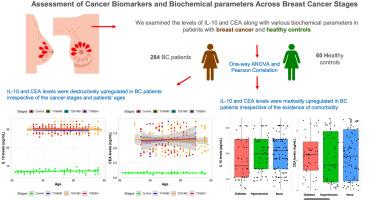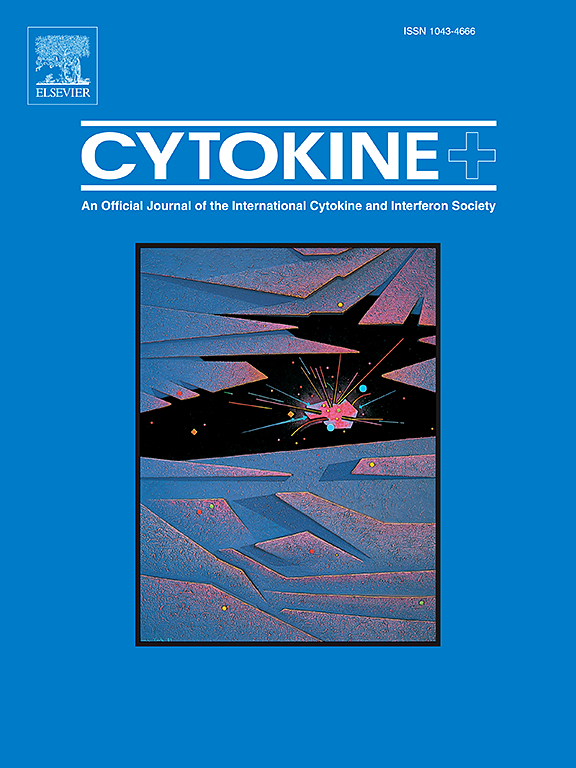乳腺癌分期癌症生物标志物和生化参数的评估:与年龄和合并症的相关性
IF 3.7
3区 医学
Q2 BIOCHEMISTRY & MOLECULAR BIOLOGY
引用次数: 0
摘要
背景和目的乳腺癌是威胁全球妇女的公共卫生问题。本研究旨在检测不同分期乳腺癌患者白细胞介素-10 (IL-10)、癌胚抗原(CEA)、癌抗原15-3 (CA 15-3)水平及各种生化指标(铁蛋白、血红蛋白(Hb)、谷胱甘肽(GSH)、乳酸脱氢酶(LDH)、碱性磷酸酶(ALP)、γ -谷氨酰转移酶(GGT)、天冬氨酸转氨酶(GOT))的变化。其次,确定患者年龄和合并症对IL-10和CEA水平的影响。方法本研究于2024年5月至11月在伊拉克基尔库克肿瘤和血液学中心进行。研究人群包括两组:284名诊断为不同阶段乳腺癌(T1N0M0、T2N1M0和T3N2M1)的女性和60名健康女性作为对照组。采用单因素方差分析(One-way ANOVA)确定对照组与不同癌症分期之间有统计学意义的差异,并采用Pearson相关系数(Pearson Correlation Coefficient)评估不同变量之间的相关性。结果IL-10和CEA水平在BC患者中呈破坏性上调;其中,与对照组相比,IL-10和CEA分别提高了4倍和7倍(IL-10分别为30.1±2.1比7.3±1.1 (pg/ml)), CEA分别为6.3±1.8比0.8±0.1 (ng/ml))。此外,BC患者表现出高水平的IL-10和CEA,与癌症分期、患者年龄和是否存在合并症无关。CA 15-3及其他生化指标(铁蛋白、血红蛋白、谷胱甘肽、LDH、ALP、GGT、GOT)水平在各癌期均较对照组显著升高(p <;0.05),均在正常范围内。然而,与对照组相比,Hb在所有癌症阶段均显著降低(p <;0.05)。结论:女性乳腺癌与IL-10和CEA的破坏性上调相关,与疾病分期、患者年龄和是否存在合并症无关。本文章由计算机程序翻译,如有差异,请以英文原文为准。

Assessment of Cancer biomarkers and biochemical parameters across breast Cancer stages: Correlation with age and comorbidities
Background and objectives
Breast cancer is a public health concern that threatens women globally. The study aimed to examine the levels of Interleukin-10 (IL-10), carcinoembryonic antigen (CEA) and cancer antigen 15–3 (CA 15–3), along with various biochemical parameters (ferritin, hemoglobin (Hb), glutathione (GSH), lactate dehydrogenase (LDH), alkaline phosphatase (ALP), gamma-glutamyl transferase (GGT), and aspartate aminotransferase (GOT) at different stages of breast cancer patients. Secondly, to determine the effects of patients' ages and comorbidity on the levels of IL-10 and CEA.
Methods
This study was conducted at the Kirkuk Oncology and Hematology Centre in Iraq, from May to November 2024. The study population consisted of two groups: 284 women, diagnosed with various stages of breast cancer (T1N0M0, T2N1M0, and T3N2M1) and 60 healthy women served as the control group. One-way ANOVA was used to determine statistically significant differences between control and various cancer stages, and the Pearson Correlation Coefficient to assess the correlation between different variables.
Results
Our data indicated that IL-10 and CEA levels were destructively upregulated in BC patients; specifically, IL-10 and CEA were raised four-fold and seven-fold, respectively, compared to the control group (IL-10: 30.1 ± 2.1 vs. 7.3 ± 1.1 (pg/ml), respectively), (CEA: 6.3 ± 1.8 vs. 0.8 ± 0.1 (ng/ml) respectively). Furthermore, BC patients demonstrated high levels of IL-10 and CEA, irrespective of the cancer stages, patients' ages, and the presence of comorbidity. The levels of CA 15–3 and other biochemical parameters (ferritin, Hb, GSH, LDH, ALP, GGT, GOT) were raised significantly at all cancer stages compared to the control group (p < 0.05), the values were within normal ranges. However, Hb was significantly reduced at all cancer stages compared to the control group (p < 0.05).
Conclusion
We concluded that breast cancer in women is associated with a destructive upregulation of IL-10 and CEA, irrespective of the disease stage, patients' ages, and the existence of comorbidity.
求助全文
通过发布文献求助,成功后即可免费获取论文全文。
去求助
来源期刊

Cytokine
医学-免疫学
CiteScore
7.60
自引率
2.60%
发文量
262
审稿时长
48 days
期刊介绍:
The journal Cytokine has an open access mirror journal Cytokine: X, sharing the same aims and scope, editorial team, submission system and rigorous peer review.
* Devoted exclusively to the study of the molecular biology, genetics, biochemistry, immunology, genome-wide association studies, pathobiology, diagnostic and clinical applications of all known interleukins, hematopoietic factors, growth factors, cytotoxins, interferons, new cytokines, and chemokines, Cytokine provides comprehensive coverage of cytokines and their mechanisms of actions, 12 times a year by publishing original high quality refereed scientific papers from prominent investigators in both the academic and industrial sectors.
We will publish 3 major types of manuscripts:
1) Original manuscripts describing research results.
2) Basic and clinical reviews describing cytokine actions and regulation.
3) Short commentaries/perspectives on recently published aspects of cytokines, pathogenesis and clinical results.
 求助内容:
求助内容: 应助结果提醒方式:
应助结果提醒方式:


